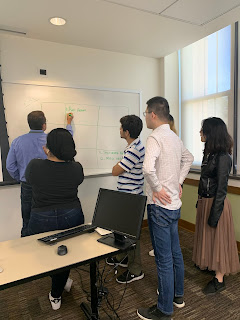Design thinking in Health Data Science

A group of Graduate students at the Georgetown HIDS program applying design thinking to Health data "Make it simple but significant" -- Don Draper, a fictional character on the AMC's TV Show Mad Men. We could easily attribute Don's success with his advertising campaigns to meticulous application of design thinking. Design thinking is a breakthrough model for human-centered innovation and problem solving where multi-disciplinary teams work iteratively to rapidly prototype products. This process of 1. Need finding 2. Ideation 3. Prototyping 4. Testing 5. Implementing and then back to 1. Need finding has been used across sectors to solve complex problems such as redesigning school curriculum to connect students to the world outside classrooms and designing future aircraft cabins. Last week, our students learned that applying design thinking to healthcare can improve patient and provider experiences as well as reduce medical errors, especially in this day an
